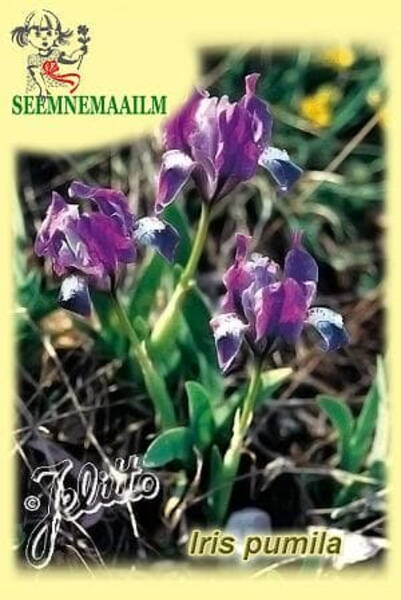Your shopping cart is empty!
Dwarf iris
Dwarf iris (wild form) - Iris pumila L. = Iris taurica Lodd. = Iris aequiloba Ledeb. = Iris alexeenkoi Grossh.
Perennial plant up to 15-20 cm high. All leaves are basal, broadly linear, glaucous. Peduncle up to 3 cm with one flower of lilac, white with a spot or wine-red color.
Blooms earlier than other species - in early May, bears fruit annually. Tolerates dry places well. One of the ancestors of the varieties of the dwarf bearded iris group. In cultivation since 1588.
Flowering clumps of Iris pumila produce a particularly great decorative effect - a property that puts this species in the category of desirable early spring perennials. Seedlings begin to bloom in the second year. Easily hybridizes not only with Iris attica, Iris pseudopumila, Iris scariosa, Iris chamaeiris, but also with species of the medium-sized group and even with species of tall bearded, especially if Iris pumila is taken as a parent plant. One of the main ancestors of a large number of varieties of the dwarf bearded iris group.
Winter hardiness zones: Z 4-8.
1.0 g = 80 seeds.

Perennial plant up to 15-20 cm high. All leaves are basal, broadly linear, glaucous. Peduncle up to 3 cm with one flower of lilac, white with a spot or wine-red color.
Blooms earlier than other species - in early May, bears fruit annually. Tolerates dry places well. One of the ancestors of the varieties of the dwarf bearded iris group. In cultivation since 1588.
Flowering clumps of Iris pumila produce a particularly great decorative effect - a property that puts this species in the category of desirable early spring perennials. Seedlings begin to bloom in the second year. Easily hybridizes not only with Iris attica, Iris pseudopumila, Iris scariosa, Iris chamaeiris, but also with species of the medium-sized group and even with species of tall bearded, especially if Iris pumila is taken as a parent plant. One of the main ancestors of a large number of varieties of the dwarf bearded iris group.
Winter hardiness zones: Z 4-8.
1.0 g = 80 seeds.













